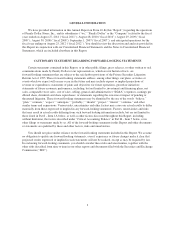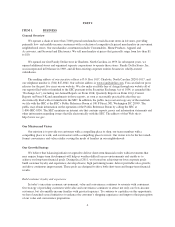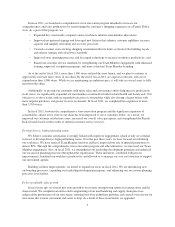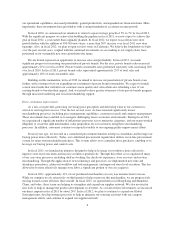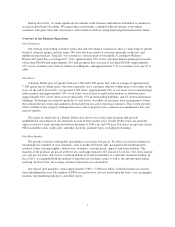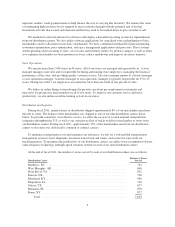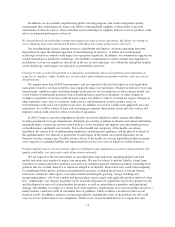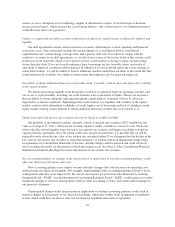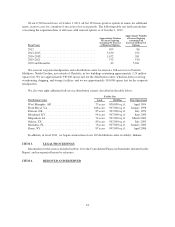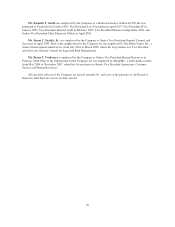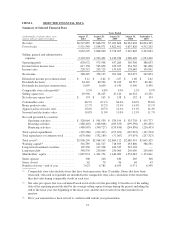Family Dollar 2011 Annual Report Download - page 17
Download and view the complete annual report
Please find page 17 of the 2011 Family Dollar annual report below. You can navigate through the pages in the report by either clicking on the pages listed below, or by using the keyword search tool below to find specific information within the annual report.In addition, we are currently implementing global sourcing programs and vendor and product quality
requirements that could negatively impact our ability to find qualified suppliers or their ability to provide
merchandise at attractive prices. These and other factors affecting our suppliers and our access to products could
affect our financial performance adversely.
We depend heavily on technology systems that support all aspects of our operations; the failure of existing or
new technology to provide anticipated benefits could affect our results of operations adversely.
Our merchandising, finance, human resources, distribution and logistics and store operations functions
depend heavily upon the efficient operation of our technological resources. A failure in our information
technology systems or controls could impact our operations negatively. In addition, we continuously upgrade our
current technology or install new technology. Our inability to implement in a timely manner such upgrades or
installations, to train our employees effectively in the use of our technology, or to obtain the anticipated benefits
of our technology could impact our operations or profitability adversely.
Changes in state or federal legislation or regulations, including the effects of legislation and regulations on
wage levels, employee rights, health care, social welfare and entitlement programs could increase our cost of
doing business.
We employ more than 50,000 team members, and are exposed to the risk that federal or state legislation,
particularly related to our team members, may negatively impact our operations. Changes in federal or state wage
requirements, employee rights (including changes in the process for our employees to join a union), health care,
social welfare or entitlement programs such as health insurance, paid leave programs, or other changes in
workplace regulation or tax laws could adversely impact our ability to achieve our financial targets. Changes in
other regulatory areas, such as consumer credit, privacy and information security, product safety or
environmental could cause our expenses to increase. In addition, if we fail to comply with applicable laws and
regulations, we could be subject to legal risk, including government enforcement action and class action civil
litigation, which could adversely affect our results of operations.
In 2010, Congress enacted comprehensive health care reform legislation which, among other things,
includes guaranteed coverage requirements, eliminates pre-existing condition exclusions and annual and lifetime
maximum limits, restricts the extent to which policies can be rescinded, and imposes new and significant taxes
on health insurers and health care benefits. Due to the breadth and complexity of the health care reform
legislation, the current lack of implementing regulations and interpretive guidance, and the phased-in nature of
the implementation, it is difficult to predict the overall impact of the health care reform legislation on our
business over the coming years. Possible adverse effects of the health care reform legislation include increased
costs, exposure to expanded liability and requirements for us to revise ways in which we conduct business.
Product and food safety concerns and the effects of legislation and regulations on product and food safety and
quality could affect our sales and results of operations adversely.
We are exposed to the risk that federal or state legislation and regulations regarding product and food
quality and safety may negatively impact our operations. We may be subject to product liability claims from
customers or actions required or penalties assessed by government agencies relating to products, including food
products that are recalled, defective or otherwise alleged to be harmful. Such claims may result from tampering
by unauthorized third parties, product contamination or spoilage, including the presence of foreign objects,
substances, chemicals, other agents, or residues introduced during the growing, storage, handling and
transportation phases. All of our vendors and their products must comply with applicable product and food safety
laws. Additionally, any changes in product safety or quality legislation or regulations may lead to product recalls
and the disposal or write-off of merchandise inventories, as well as certain fines or penalties and reputational
damage. Our inability to comply on a timely basis with regulatory requirements, or to execute product recalls in a
timely manner, could also result in substantial fines or penalties, which could have an adverse effect on our
financial results. In addition, negative customer perceptions regarding the safety of the products we sell could
cause us to lose market share to our competitors. If this occurs, it may be difficult for us to regain lost sales.
13


